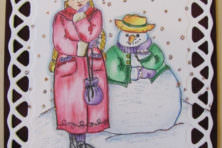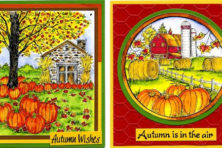Scrapbooking Past and Present
- Share
- Tweet
- Pin
- Share

Scissors, paste, paper and embellishments make the basis of any scrapbooker’s supply collection.
Samuel L. Clemens, the “father of American literature” more commonly known by his pen name of Mark Twain, is perhaps best known for his great American novel, Adventures of Huckleberry Finn. But when Clemens wasn’t working on manuscripts or writing for obscure newspapers, he was collecting souvenirs, photos and articles for his scrapbooks, another of his lifelong passions.
Clemens also had a desire to invent, though two out of three of his patented inventions (an adjustable and detachable elastic strap for garments that would replace suspenders, along with a history trivia game) would not prove to be commercially successful. The third, inspired by his love of scrapbooking and subsequent hatred for hardened glue, would become not only his most commercially successful invention, but also his most lucrative book.
In 1872, Clemens invented Mark Twain’s Adhesive Scrap-Book, a self-pasting scrapbook that included adhesive strips that, once moistened, would become sticky and allow scrapbookers to make updates easily and neatly. He acquired the patent in June 1873 and began marketing and selling the book which, according to an 1885 St. Louis Post-Dispatch article, earned Twain $50,000 compared to $200,000 for all of his other books combined. Clemens called the invention the “only rational scrapbook the world has ever seen.” According to the PBS website, Mark Twain’s Interactive Scrapbook, by 1901, 57 different types of his albums were available.
In the more than 140 years since Clemens’ invention, scrapbooking’s popularity has ebbed and flowed, with recessions, the invention of the Kodak camera, and mass production of photo albums influencing the popularity of what The Scrapbook in America describes as “a material manifestation of memory.” But in 1976, when a woman named Marielen Christensen began making creative pages on which she would paste family photos, slide into sheet protectors, and clip into three ring binders, people took notice.
Four years later, Christensen was asked to put her more than 50 family memory books on display at The World Conference on Records in Salt Lake City, Utah. Interest was immediate and Christensen began teaching classes and giving seminars on how to create memory books. A year later, she and her husband wrote a how-to book and started the mail-order business, Keeping Memories Alive. The pastime has enjoyed growing popularity ever since and is enjoyed for not only keeping memories, but creating social networks as well.
Laura Moegenburg, owner of Paper Work Plus in Sister Bay, recalls the early days of scrapbooking’s popularity in the 1980s and has witnessed the evolution firsthand, from the “primitive” concept of cutting pictures out in shapes to today’s technologically advanced hobby where machines can do the cutout work for you.
Moegenburg was inspired to scrapbook 10 years ago after a friend’s major life event, which prompted her to look more closely at how she documents her own life.
“One of my girlfriends had a baby later in life and she thinks she’s not very artistic so she asked me to help her make a scrapbook for her daughter,” she said. “So then I got really sad and I realized all that cute stuff, things you think you’ll remember that your kids did or said. I hadn’t remembered any of it and at that point, my kids were in their late teens and early 20s. I realized just how important a person’s life is – if you don’t write it down, nobody is going to remember. A whole life can be forgotten.”
Today, scrapbooking is an integral part of Moegenburg’s daily routine. Each day is documented with a photo and a few lines of writing, whether it’s her hairstyle for the day, what’s going on in her garden, or what she had for lunch.
“It’s the everyday stuff that you want to look back and remember,” she said. “What your little girl said that was so cute and made you laugh. What your favorite dinner was, stuff like that that 20 years from now you won’t remember.”
It is an easy “addiction” for her to feed, considering up to a fourth of what her store carries is scrapbooking products – stickers, binders, tape and paper. She attends trade shows to keep up with the trends and notices markedly different interests among differing generations.
Today’s trends include wood embellishments, vellum paper, gold foil accents, word stickers, washi tape (pretty patterned tape made of natural fibers) and scalloped scissors. Technological innovations have also made their way into the favorite pastime, including paper die cutting machines that hook up to computers and can create paper cutouts of any image or font.
“The tools have really gotten sophisticated in the last 20 years,” Moegenburg said.
But no matter the means by which a scrapbook is created, the message remains the same: preserve the delicate memories of everyday life.
“Anybody can – it’s a picture with stickers on it. That’s all it is,” she said. “It’s simple and it’s just your life. There’s no right and there’s no wrong. That’s the beauty of it.”



